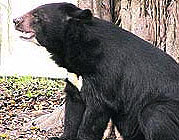|
Bhutan's
Nature - Animals
|
 |
Bhutan Nature Animals |
|
 |
Bhutan Information |
|
|
 |
 |
Himalayan
black bear Ursus thibetanus
The
Himalayan black bear is one of the five species of black bear. The Himalayan
black bear reaches lengths up to 1.95 m feet and can weigh up to 120 kg.
The tail is stubby, the ears are large and the fur is silky and smooth.
|
|
The coat of the Himalayan black bear is marked by a distinctive white crest
on the chest and a white spot on the chin. The nose of the bear is chestnut
brown.
The
Himalayan Black Bear is a widespread denizen of temperate forests at elevations
between 550 m and 3,700. Black in color with a distinctive white V on its
chest, it grows to 2.10 m in height, preferring to live in steep, forested
hills. In winter, most bears come down to the lower valleys, somewhere
around 1,500 m. In summer, the bear feeds mainly on wild fruit and berries.
| About
Himalayan black bears |
 |
| Name |
Himalayan
black bear Ursus thibetanus in Bhutan |
| Habitat |
They
inhabit forested areas, particularly hill and mountainous regions. |
| Diet |
Asiatic
black bears are more carnivorous than their American counterparts, although
only a small part of their diet is made up of meat. This includes small
mammals, birds, fish, molluscs and carcasses. They also feed on grasses,
fruits, berries, seeds, insects and honey. In autumn they fatten up for
the winter by feeding on nuts. |
Physical
Appearance |
Asiatic
black bears have long black fur with a distinct white patch on the chest
that is often crescent-shaped. The fur around the shoulders and throat
is particularly long, and their ears are relatively large. |
Social
Behavior |
Asiatic
black bears are solitary except for maternal family groups, and occupy
a home range of 10-20 square km. They are most active at night, although
in some areas they may be active during the day as well. |
|
 |
|
Ursus
thibetanus (Asiatic Black Bear) - A vulnerable species |
 |
The
principal color phase is black, with a white "crescent moon" on the chest.
Rare brown phases are also known, and recently a blond (and mixed blond
and black) color phase was discovered in Cambodia, Thailand, and Laos .
This
species occupies a narrow band from southeastern Iran eastward through
Afghanistan and Pakistan, across the foothills of the Himalayas, to Myanmar.
It occupies all countries in mainland Southeast Asia except Malaysia.
Asiatic
black bears occupy a variety of forested habitats, both broad-leaved and
coniferous, from near sea level to an elevation of 4300m (in northeastern
India). They also infrequently use open alpine meadows. Individual bears
move to different habitats and elevations seasonally, tracking changes
in food abundance. Foods include succulent vegetation (shoots, forbs
and leaves) in spring, turning to insects and a variety of tree and shrub-borne
fruits in summer, and finally nuts in autumn. In some places the diet contains
a sizeable portion of meat from mammalian ungulates.
In
temperate forests, Asiatic black bears rely heavily on hard mast in autumn,
in part to put on sufficient fat reserves for winter denning (hibernation).
Therefore, these bears tend to focus their activities in habitats with
high abundance of oak acorns, beechnuts, walnuts, chestnuts, hazelnuts,
or stone pine seeds. When Asiatic black bears feed in hard mast trees they
often break branches and pile them up in the canopy, forming what appears
to be a platform or "nest".
In
the most northerly parts of their range, bears enter dens as early as October
and exit as late as the end of May.
In
the tropics, Asiatic black bears generally do not hibernate, except females
giving birth during winter. They still make use of hard mast, but additionally
consume numerous species of soft fruits.
Asiatic
black bears also use regenerating forests, which may have a high production
of berries or young bamboo shoots. They also feed in plantations, where
they may damage trees by stripping the bark and eating cambium, and in
cultivated areas, especially corn and oat fields and fruit orchards.
Asiatic
black bears generally breed during June-July and give birth during November -
March; however, timing of reproduction is not known for all portions of
the range. Age of first reproduction is 4-5 years, and they normally
produce litters of 1 or 2 cubs every other year (at most). Maximum
lifespan is over 30 years, but average lifespan is less in the wild.
Widespread
illegal killing of bears and trade in parts, combined with loss of habitat
indicate that this species is likely declining in most parts of its range,
especially in Southeast Asia and China.
| Source:
International Union for Conservation of Nature IUCN |
 |
top
| Wildlife and People in Bhutan |
 |
| Information on Bhutan |
 |
| Links |
 |
|






